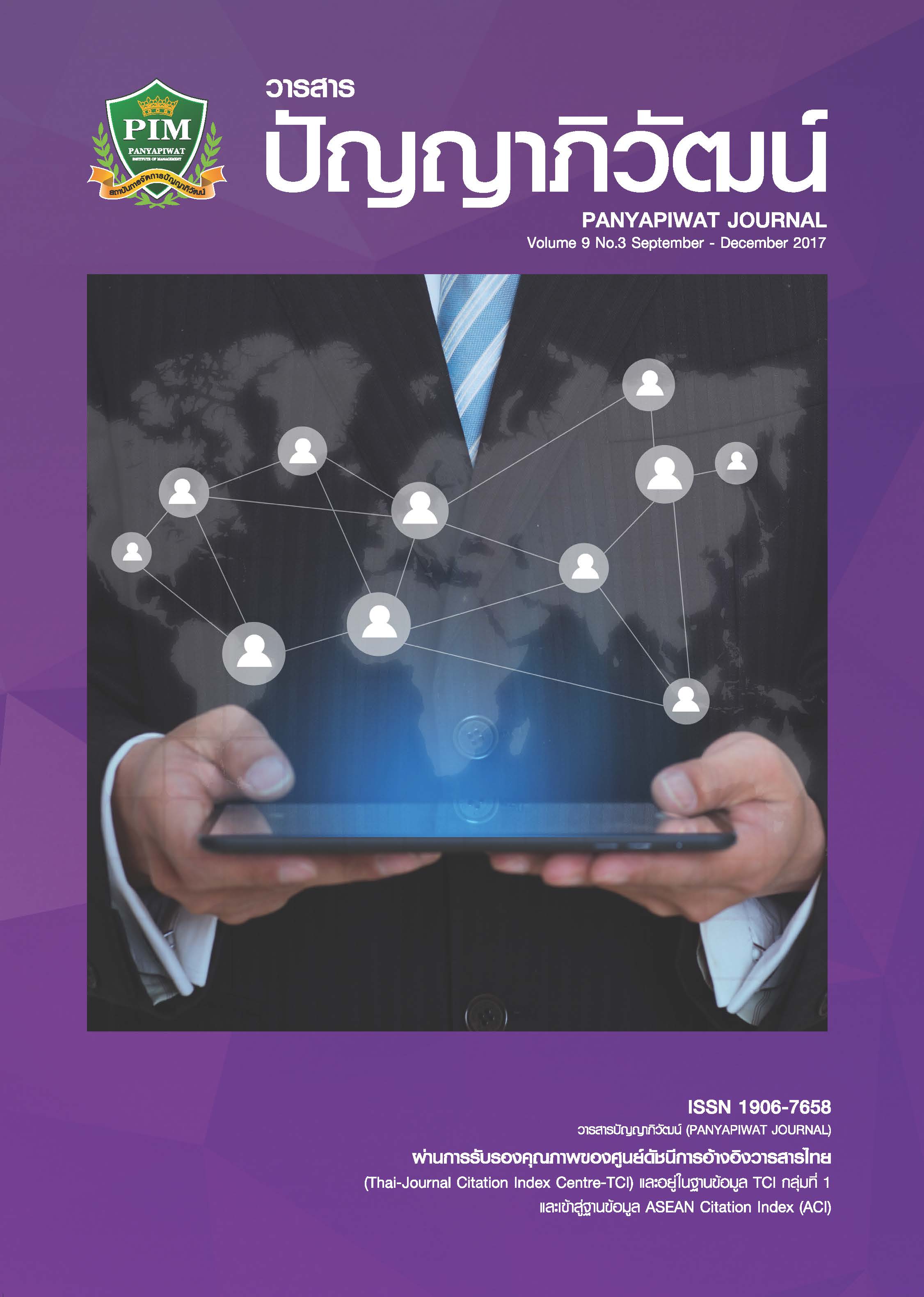วิถีชา: ต้นแบบวัฒนธรรมการต้อนรับของญี่ปุ่น
Main Article Content
บทคัดย่อ
ญี่ปุ่นรับเอาวัฒนธรรมการดื่มชามาจากประเทศจีนและนำไปประยุกต์หลอมรวมกับปรัชญาความเชื่อของศาสนาพุทธนิกายเซนรวมทั้งผสมกลมกลืนกับประเพณีวัฒนธรรมความเชื่อดั้งเดิมของญี่ปุ่นจนเกิดเป็น วิถีชา “The Way of Tea” ที่เรียกในภาษาญี่ปุ่นว่า 茶道 Sa-dou หรือ Cha-dou ซึ่งเป็นต้นแบบของวัฒนธรรมการต้อนรับของญี่ปุ่นที่เน้นการปฏิบัติต่อผู้อื่นด้วยความเสมอภาค และสร้างความพึงพอใจสูงสุดให้เกิดแก่ผู้ที่เป็นแขก ด้วยความเชื่อที่ว่าคนเราอาจมีโอกาสพบกันเพียงครั้งเดียวในชีวิต หรือในการพบกันแต่ละครั้งอาจเป็นครั้งสุดท้ายที่จะได้พบกัน ดังนั้นจึงควรต้องให้การต้อนรับอย่างดีที่สุด สร้างความประทับใจที่สุดเพื่อเป็นการให้เกียรติกันและกัน แนวคิดดังกล่าวนี้ทำให้วัฒนธรรมการต้อนรับของสังคมญี่ปุ่นมีความโดดเด่น เนื่องจากเกิดบนพื้นฐานหลักปรัชญาซึ่งไม่เหมือนสังคมใดในโลก
Japan adopted the culture of tea from China and created a fusion of philosophical beliefs of Zen Buddhism and traditional Japanese culture, resulting in “The Way of Tea” or 茶道 Sa-dou or Cha-dou in Japanese. This combination has set a precedent for the Japanese hospitality culture that focuses on treatment of equality and utmost satisfaction bestowed on guests. It is a belief that a person may have only one chance of meeting the other person, in his/her life, or that each meeting may be the last. For this reason, each reception should be most courteous, impressive and honorable to each party. This principle or the philosophy of Sa-dou has made the Japanese hospitality culture an unsurpassed and unique to the world.
Article Details
“ข้าพเจ้าและผู้เขียนร่วม (ถ้ามี) ขอรับรองว่า บทความที่เสนอมานี้ยังไม่เคยได้รับการตีพิมพ์และไม่ได้อยู่ระหว่างกระบวนการพิจารณาลงตีพิมพ์ในวารสารหรือแหล่งเผยแพร่อื่นใด ข้าพเจ้าและผู้เขียนร่วมยอมรับหลักเกณฑ์การพิจารณาต้นฉบับ ทั้งยินยอมให้กองบรรณาธิการมีสิทธิ์พิจารณาและตรวจแก้ต้นฉบับได้ตามที่เห็นสมควร พร้อมนี้ขอมอบลิขสิทธิ์บทความที่ได้รับการตีพิมพ์ให้แก่สถาบันการจัดการปัญญาภิวัฒน์หากมีการฟ้องร้องเรื่องการละเมิดลิขสิทธิ์เกี่ยวกับภาพ กราฟ ข้อความส่วนใดส่วนหนึ่งและ/หรือข้อคิดเห็นที่ปรากฏในบทความข้าพเจ้าและผู้เขียนร่วมยินยอมรับผิดชอบแต่เพียงฝ่ายเดียว”
เอกสารอ้างอิง
Dansilpa, K. (2002). The Delights of Tea. Bangkok: Iknueng Press. [in Thai]
Eto, H., Dey, N., Liu, I-C. & Roy, P. (2015). Comprehensive Study of Tea Culture and Its Possible Contribution to Creativity Education in Locals.International Journal of Research in Sociology and Anthropology (IJRSA), 1(1), 54-64.
Fling, S. (1998).Psychological Aspects of the Way of Tea. Japanese Studies Association Journal, 2, 29-36.
Haga, K. (1989). The wabi aesthetic through the eges. In Varely, P. (Ed.). Tea in Japan: Essay on the History of Chanoyu. USA: University of Hawaii Press, Honolulu.
Harnkarnchanasuwat, S. (2012). Resurgence of Chinese Tea Consumption as “High Culture” in Contemporary Bangkok Metropolis. Bangkok: A Dissertation Submitted in Portial Fullfillment of the Requirements for the Degree of Doctor of Philosophy Program in Thai Studies Faculty of Arts Chulalongkorn University.
Hattori, K. (2008). Recommendation of Hospitality Science. Tokyo: Murazen.
Japan National Tourism Organization. (2002). Tea Ceremony: Ceremonial tea-room. Retrieved December 15, 2016, from https://www.jnto.go.jp/eng/indepth/cultural/experience/f.html
Kondo, D. (1985). The way of tea: a symbolic analysis.Man London, 20(2), 287-306.
Okubo, T. (2005). Shinyaku Cha no Hon(13th ed.). Tokyo: Kodokawa. [in Japanese]
Phitchomphu, P. (2010). Tea: Contemporary Health Drink. Bangkok: PlanB Press. [in Thai]
Rungrasami, R. (2006). The Aroma of Tea (4th ed.). Bangkok: Praew Press. [in Thai]
Sakae, T. (2005). Cha to Omotenashi no bunka.Tokyo: NTT. [in Japanese]
Sato, Y. & Parry, M. E. (2015). The influence of the Japanese tea ceremony on Japanese restaurant hospitality.Journal of Consumer Marketing, 32(7), 520-529.
Shufunotomosha. (2005). Kettei Ban OchaDaizukan. Bangkok: Blue Sky Press. [in Thai]
Soshitsu, S. (1996). Sadounyuumon. Kyoto: Tankosha. [in Japanese]
Thepkampanat, A. (2005). Meaning Concept and Issue about “Culture”. Retrieved June 19, 2016, from https://www.culture.go.th [in Thai]
Tripadvisor. (2017). Photo “Tea House”: Kodai-ji Temple. Retrieved January 12, 2017, from https://www.tripadvisor.com/LocationPhotoDirectLink-g298564-d321402-i189171563-Kodai_ji_Temple-Kyoto_Kyoto_Prefecture_Kinki.html
Wachiradilok, W. (2004). “Japanese Tea” in Eastern Heart. Bangkok: Thammasat University Press Rangsit Campus. [in Thai]


